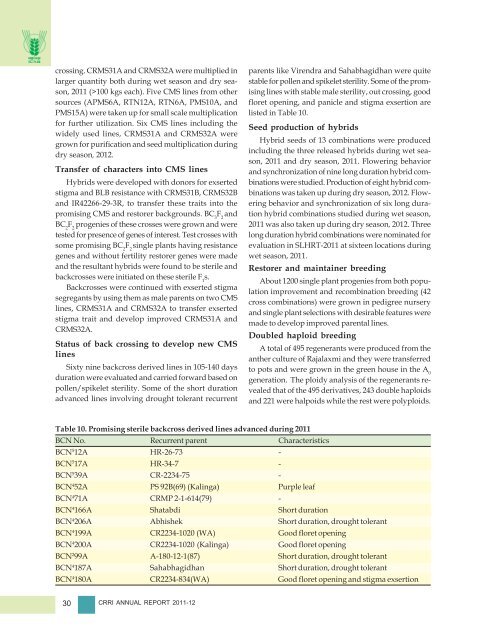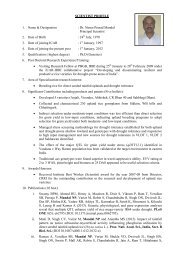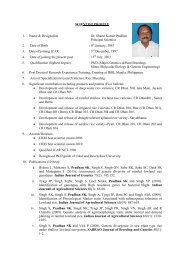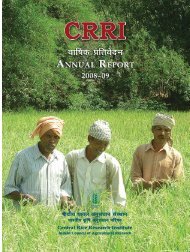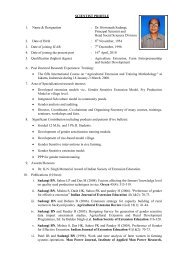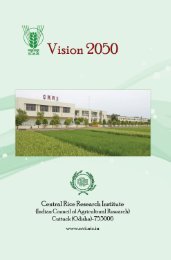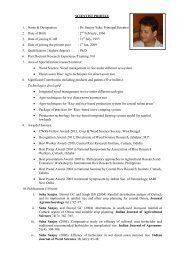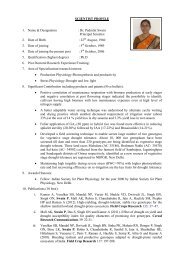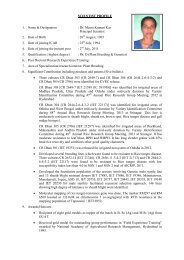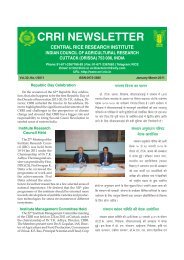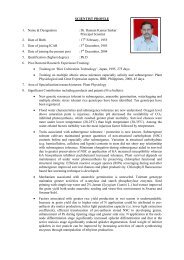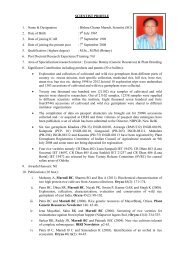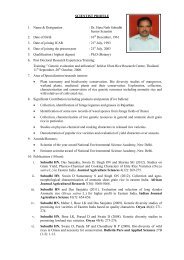Central Rice Research Institute Annual report...2011-12
Central Rice Research Institute Annual report...2011-12
Central Rice Research Institute Annual report...2011-12
You also want an ePaper? Increase the reach of your titles
YUMPU automatically turns print PDFs into web optimized ePapers that Google loves.
crossing. CRMS31A and CRMS32A were multiplied in<br />
larger quantity both during wet season and dry season,<br />
2011 (>100 kgs each). Five CMS lines from other<br />
sources (APMS6A, RTN<strong>12</strong>A, RTN6A, PMS10A, and<br />
PMS15A) were taken up for small scale multiplication<br />
for further utilization. Six CMS lines including the<br />
widely used lines, CRMS31A and CRMS32A were<br />
grown for purification and seed multiplication during<br />
dry season, 20<strong>12</strong>.<br />
Transfer of characters into CMS lines<br />
Hybrids were developed with donors for exserted<br />
stigma and BLB resistance with CRMS31B, CRMS32B<br />
and IR42266-29-3R, to transfer these traits into the<br />
promising CMS and restorer backgrounds. BC 3<br />
F 2<br />
and<br />
BC 2<br />
F 2<br />
progenies of these crosses were grown and were<br />
tested for presence of genes of interest. Test crosses with<br />
some promising BC 2<br />
F 2<br />
single plants having resistance<br />
genes and without fertility restorer genes were made<br />
and the resultant hybrids were found to be sterile and<br />
backcrosses were initiated on these sterile F 1<br />
s.<br />
Backcrosses were continued with exserted stigma<br />
segregants by using them as male parents on two CMS<br />
lines, CRMS31A and CRMS32A to transfer exserted<br />
stigma trait and develop improved CRMS31A and<br />
CRMS32A.<br />
Status of back crossing to develop new CMS<br />
lines<br />
Sixty nine backcross derived lines in 105-140 days<br />
duration were evaluated and carried forward based on<br />
pollen/spikelet sterility. Some of the short duration<br />
advanced lines involving drought tolerant recurrent<br />
parents like Virendra and Sahabhagidhan were quite<br />
stable for pollen and spikelet sterility. Some of the promising<br />
lines with stable male sterility, out crossing, good<br />
floret opening, and panicle and stigma exsertion are<br />
listed in Table 10.<br />
Seed production of hybrids<br />
Hybrid seeds of 13 combinations were produced<br />
including the three released hybrids during wet season,<br />
2011 and dry season, 2011. Flowering behavior<br />
and synchronization of nine long duration hybrid combinations<br />
were studied. Production of eight hybrid combinations<br />
was taken up during dry season, 20<strong>12</strong>. Flowering<br />
behavior and synchronization of six long duration<br />
hybrid combinations studied during wet season,<br />
2011 was also taken up during dry season, 20<strong>12</strong>. Three<br />
long duration hybrid combinations were nominated for<br />
evaluation in SLHRT-2011 at sixteen locations during<br />
wet season, 2011.<br />
Restorer and maintainer breeding<br />
About <strong>12</strong>00 single plant progenies from both population<br />
improvement and recombination breeding (42<br />
cross combinations) were grown in pedigree nursery<br />
and single plant selections with desirable features were<br />
made to develop improved parental lines.<br />
Doubled haploid breeding<br />
A total of 495 regenerants were produced from the<br />
anther culture of Rajalaxmi and they were transferred<br />
to pots and were grown in the green house in the A 0<br />
generation. The ploidy analysis of the regenerants revealed<br />
that of the 495 derivatives, 243 double haploids<br />
and 221 were halpoids while the rest were polyploids.<br />
Table 10. Promising sterile backcross derived lines advanced during 2011<br />
BCN No. Recurrent parent Characteristics<br />
BCN 5 <strong>12</strong>A HR-26-73 -<br />
BCN 5 17A HR-34-7 -<br />
BCN 5 39A CR-2234-75 -<br />
BCN 4 52A PS 92B(69) (Kalinga) Purple leaf<br />
BCN 4 71A CRMP 2-1-614(79) -<br />
BCN 4 166A Shatabdi Short duration<br />
BCN 4 206A Abhishek Short duration, drought tolerant<br />
BCN 4 199A CR2234-1020 (WA) Good floret opening<br />
BCN 4 200A CR2234-1020 (Kalinga) Good floret opening<br />
BCN 2 99A A-180-<strong>12</strong>-1(87) Short duration, drought tolerant<br />
BCN 4 187A Sahabhagidhan Short duration, drought tolerant<br />
BCN 4 180A CR2234-834(WA) Good floret opening and stigma exsertion<br />
30 CRRI ANNUAL REPORT 2011-<strong>12</strong>


